Nguyen Trong Anh0471973580, 9780471973584, 0471973599, 9780471973591, 9780470065693
Frontier Orbitals is aimed at experimentalists who are well versed in organic chemistry but have little or no understanding of quantum mechanics. A greater emphasis is put on chemistry than on quantum mechanics, and the intelligent use of the rules rather than their mathematical derivation.
Table of contents :
FRONTIER ORBITALS……Page 4
Contents……Page 12
Acknowledgments……Page 10
Preface……Page 16
1.1 The Advantages of the Perturbation Method……Page 18
1.2.1 Five Standard Frontier Orbital Treatments of Reactivity……Page 19
1.2.2 Three Standard Frontier Orbital Treatments of Structural Problems……Page 20
2.1 Atomic Orbitals……Page 22
2.2 Molecular Orbitals……Page 26
2.3.1 Calculations……Page 27
2.3.2 A Physical Interpretation……Page 29
2.4.1 Calculations……Page 32
2.5.1 The Hückel Method for Polyatomic Molecules……Page 33
2.5.2 How to Calculate Hückel MOs……Page 38
2.6 To Dig Deeper……Page 41
3.1 Perturbations and Hückel Methods……Page 42
3.2.1 Two-orbital Systems……Page 43
3.2.2 Systems Having More than Two Orbitals……Page 44
3.2.4 Unimolecular Systems……Page 45
3.3.1 Numerical Calculations……Page 46
3.3.2 Qualitative Applications……Page 49
3.4.1 Alternant Hydrocarbons……Page 52
3.4.2 The Dewar PMO Method……Page 55
3.4.3 Advantages and Disadvantages of the PMO Method……Page 60
3.5 To Dig Deeper……Page 61
4 Absolute and Relative Reactivities……Page 64
4.1.1 Bimolecular Reactions……Page 65
4.1.2 Unimolecular Reactions……Page 69
4.2.1 Electrophilic Reactions……Page 74
4.2.2 Nucleophilic Reactions……Page 77
4.2.3 Cycloadditions……Page 83
4.3.1 Some Difficulties Encountered with Rule 1……Page 89
4.3.2 Problems with Rule 2……Page 92
5.1 Cycloadditions……Page 104
5.2.2 Regioselectivity Involving Enols and Enolates……Page 113
5.2.3 FO Theory and Ionic Reactions……Page 119
5.3.1 Additions to Conjugated Carbonyl Compounds……Page 123
5.4 Radical Reactions……Page 127
5.5 Periselectivity……Page 129
5.6 Limitations of Rule 3……Page 130
6.1.1 Electrocyclic Reactions……Page 146
6.1.2 Sigmatropic Rearrangements……Page 155
6.1.3 Cycloadditions and their orientations……Page 156
6.2.1 Nucleophilic Additions……Page 161
6.2.2 Electrophilic Additions……Page 189
6.2.3 Application to the Aldol Addition……Page 192
6.3.2 Bimolecular Nucleophilic Substitutions……Page 195
6.4 The Limitations of Rule 4……Page 198
7.1 Principle of the Method……Page 204
7.2.1 Aldehydes, Alkenes and Enol Ethers……Page 205
7.2.2 Conformations of Some Ions……Page 212
7.2.3 The Anomeric Effect……Page 217
7.2.4 The Geminal Effect……Page 220
7.2.5 The Gauche Effect……Page 221
7.3 Reactive Conformations……Page 223
7.4.1 Cyclobutadiene……Page 224
7.4.2 Trimethylenemethane……Page 225
7.4.3 Stable Carbenes……Page 226
7.5.1 Structural Consequences of HOMO–LUMO Interactions……Page 227
7.5.2 Applications to Nucleophilic Additions……Page 228
7.5.3 Substituent Effects……Page 229
7.6 Abnormal Valence Angles……Page 245
8 Going Further……Page 248
8.1.2 Consequences……Page 249
8.2.2 Reactivity Problems……Page 252
8.2.3 Beyond Potential Surfaces……Page 253
8.3.1 The Approximations……Page 254
8.3.2 The Principal Theoretical Models……Page 255
8.3.3 A Few Technical Points……Page 259
8.4 To Dig Deeper……Page 261
A2 Chapter 3……Page 262
A3 Chapter 4……Page 264
A4 Chapter 5……Page 281
A5 Chapter 6……Page 293
A6 Summary Table……Page 294
Index……Page 298







Reviews
There are no reviews yet.